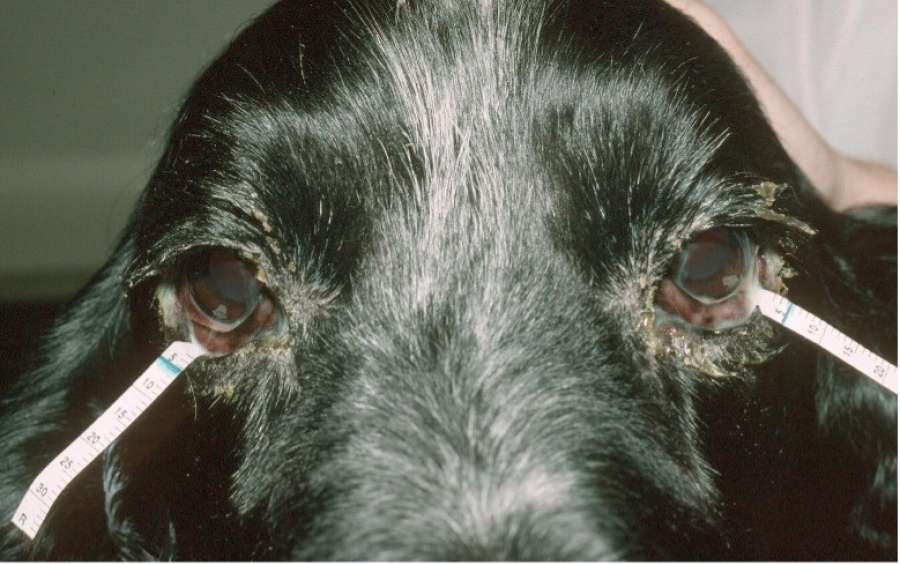Dry Eye
Dry Eye (Keratoconjunctivitis sicca)
Dry eye in dogs is a condition caused by inadequate tear production. Tears are important for eye-health as they protect, nourish and lubricate the eyes
Tears contain:
- An aqueous component (water) to keep the eye moist
- Oils to lubricate the eye and help it move smoothly
- Mucous to evenly spread water and oils across the eye
- Immune (disease fighting) cells and protein to protect the eye from infections
The lacrimal (tear producing) gland at the inner corner of the eye produces most of a dog’s watery tears with the rest coming from a gland in the third eyelid. Dry eye is when these glands don’t produce enough tears causing the cornea (clear surface of the eye) to become dry, sore and sometimes ulcerated (open sores).
Causes of dry eye
Keratoconjunctivitis sicca (KCS) - KCS is the most common cause of dry eye. Dogs with KCS have an overactive immune (disease fighting) system that destroys their own tear-producing cells.
Some dogs have a genetic predisposition (born more likely to develop) KCS.
They include: Cavalier King Charles Spaniels, West Highland White Terriers, Yorkshire Terriers, Bull dogs, Springer Spaniels, Miniature Schnauzers, Pugs and Shih Tzus.
Neurogenic - Infections or problems affecting the nerves controlling tear-producing glands can cause dry eye.
Hormonal - Hypothyroidism (an underactive thyroid gland) can cause reduced tear production.
KCS can be a side effect of some medications.
Congenital - Some dogs are born with abnormal tear glands meaning they are unable to produce normal tears. This has been reported in Yorkshire Terriers and Cocker Spaniels.
Signs of dry eye
Dry eye is a painful condition causing red, itchy eyes. Most dogs find it difficult to keep their eyes open and blink a lot. A lack of watery tears causes a thick, yellow discharge. Eyes lose their ‘shine’ and appear dull.
Sometimes corneal ulcers (open sores) develop making the cornea appear grey and cloudy. A consequence of corneal ulcers is hyperpigmentation (darkening) of the cornea. This is a sign of corneal scarring.
Diagnosing dry eye
Your vet will fully examine your dog then perform an ophthalmic (eye) examination. Part of this involves carrying out a Schirmer tear test to measure the amount of watery tears your dog produces. Your dog might need blood tests to check for any underlying conditions.
At Focus, we have specialist equipment to look at your dog’s eyes in great detail and from all angles.

What treatment is available?
Managing your dog’s dry eye is a lifelong commitment. Most dogs need a combination of daily treatments to keep their symptoms under control.
Medications
Optimmune ™ ointment and tacrolimus drops work on the tear glands to stimulate production.
Pilocarpine can be applied to the eyes or given in your dog’s food which can help stimulate the tear production in neurogenic cases of dry eye
False tear drops are available to replace the tears your dog can’t produce
Antibiotic drops or ointments treat and prevent infections
Bathing your dog’s eyes keeps them comfortable and helps prevent infections
At Focus, we’ll work closely with your own vet to plan the most suitable treatment for your dog.
Surgery
As dry eye progresses, medication might not be enough to control your dog’s symptoms (or it can become too difficult applying regular, frequent eye-drops).
Some dogs are suitable candidates for a surgical procedure called a Parotid Duct Transposition. This operation involves redirecting the duct (tube) from your dog’s parotid (cheek) salivary gland to just under the eye. Saliva can then pass across your dog’s eye keeping it moist and comfortable.
Parotid Duct Transposition surgery at Focus Referrals
Your dog will spend the day with us as an inpatient. We fully examine your dog on the morning of surgery to make sure they’re well enough for the operation.
We carry out Parotid Duct Transposition surgery under a general anaesthetic (your dog is fully asleep). Our nurses carefully monitor your dog throughout surgery and while they recover.
There will be small wounds on the side of your dog’s face, inside their mouth and on their lower eyelid.
What happens after surgery?
We don’t need to remove your dog’s stitches as they dissolve on their own.
We’ll ask you to feed your dog small amounts every 2 to 3 hours. This stimulates the parotid duct to produce saliva which wets and lubricates the eye. Your dog will produce tears on the operated side whenever they eat food.
Your dog will need to wear a buster collar at all times for 10 days to prevent him/her scratching and rubbing the wounds.
There’s a bit of homework for you after the surgery as your dog will need eye creams, antibiotic tablets and painkillers for at least 7 days following surgery. We’ll check your dog about a week after surgery but you can call us anytime with questions.
How successful is Parotid Duct Transposition surgery?
Based on a recent study (Rhodes et al, 2012) the overall success rate of a Parotid Duct Transposition is very high with the majority of owners reporting that they would go ahead with the surgery again knowing what they knew after the procedure.
However, the eye can become very wet with saliva sometimes leading to minor complications including mineral deposition on the surface of the eye and skin infections around the eye.
These minor complications can usually be managed with medication and a change in diet.
If you’d like to find out how Focus can help treat your dog’s dry eye, please ask your vet to get in touch with us.

